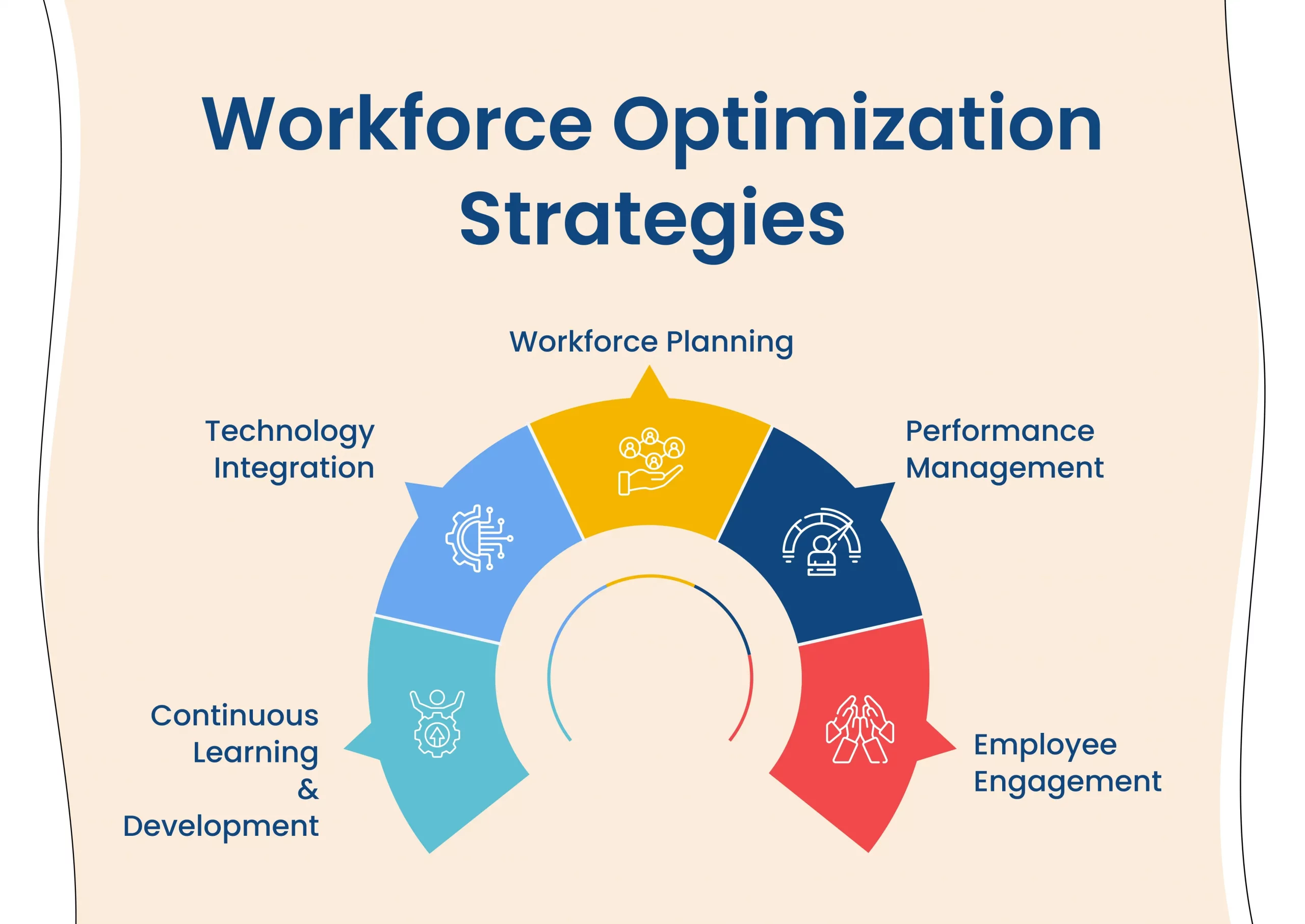Is your business truly operating at peak potential, or are hidden inefficiencies quietly holding you back from reaching your goals? In today’s competitive market, even small productivity gaps can lead to significant losses in revenue and customer satisfaction. Research shows that organizations that actively implement workforce optimization strategies can boost overall productivity by up to 25%, improve employee engagement, and reduce operational costs.
But what exactly is workforce optimization, and how can it help your business overcome common challenges like fluctuating demand, skill shortages, and workflow bottlenecks? This comprehensive guide will answer the question “what is workforce optimization” by breaking down its core principles, proven strategies, essential tools, and potential obstacles. By understanding how to strategically align your human resources with your broader business objectives, you can unlock new levels of efficiency and performance—driving growth and long-term success.
What is Workforce Optimization?
Workforce optimization is a strategic approach to maximizing the efficiency and productivity of an organization’s workforce. It involves analyzing and improving all aspects of workforce management, including:
- Staffing and scheduling
- Performance tracking
- Employee engagement
- Skills development
By leveraging data-driven insights and aligning workforce capabilities with business demands, companies can reduce costs, increase output, and enhance customer satisfaction.
Why Workforce Optimization Matters
Workforce optimization goes beyond simply cutting labor costs—it’s a strategic approach to building a flexible, skilled, and motivated team that aligns perfectly with your business goals. This alignment drives operational excellence, improves employee satisfaction, and ultimately boosts your bottom line.
Here’s why workforce optimization is crucial for modern organizations:
Increased Efficiency
By ensuring the right employees with the right skills are scheduled at the right times, workforce optimization minimizes downtime and eliminates bottlenecks. This strategic workforce planning means tasks are completed faster and workflows remain smooth, preventing delays that can cascade across departments. For example, aligning customer service reps’ shifts with peak call volumes reduces wait times and improves resolution rates.
Cost Savings
Accurate demand forecasting and staffing help organizations avoid costly pitfalls like overstaffing, which drains budgets, or understaffing, which risks lost sales and burnout. Workforce optimization tools analyze historical data and predict future workforce needs, enabling precise scheduling that balances labor costs with productivity. This careful calibration reduces overtime expenses and improves resource allocation.
Improved Customer Satisfaction
When your workforce is optimized, customers experience faster response times, personalized interactions, and consistent service quality. Having the right people available during high-demand periods prevents long wait times and errors, leading to higher satisfaction and loyalty. For retail or hospitality industries, this can mean the difference between a one-time buyer and a repeat customer.
Higher Quality and Compliance
Consistent performance management, training, and clear expectations result in higher-quality work output. Workforce optimization also helps maintain compliance with labor laws and industry regulations by tracking hours, breaks, certifications, and other requirements. This reduces legal risks and ensures standards are met across the board.
Proven Workforce Optimization Strategies
Understanding what is workforce optimization is key to implementing effective strategies that maximize productivity and streamline operations. A multi-faceted approach ensures your workforce aligns perfectly with business goals:
Workforce Planning
Strategic workforce planning is foundational to optimization. This involves forecasting future labor requirements aligned with your company’s growth objectives, seasonal trends, and market fluctuations. By analyzing historical data and business forecasts, organizations can identify critical skill gaps and proactively develop talent pipelines.
Effective workforce planning ensures the right people with the right skills are available when and where they are needed, reducing both understaffing and overstaffing risks. Leveraging talent management solutions can automate and enhance this forecasting process for greater accuracy.
Performance Management
A robust performance management system is essential for aligning individual contributions with organizational goals. Set clear, measurable Key Performance Indicators (KPIs) and conduct regular performance reviews to provide constructive feedback. This encourages accountability, motivates employees, and identifies opportunities for development.
Integrating performance data with workforce management software enables managers to monitor productivity trends and tailor interventions that boost overall team effectiveness.
Employee Engagement
Highly engaged employees are critical to sustaining workforce optimization. Cultivating a positive work culture that recognizes achievements, supports professional growth, and promotes work-life balance leads to increased motivation and lower turnover rates.
Engagement strategies might include regular check-ins, incentive programs, and flexible scheduling options facilitated by employee productivity tools.
Technology Integration
Modern workforce optimization heavily relies on technology integration. Utilizing advanced scheduling tools, time tracking systems, and real-time analytics platforms streamlines operational workflows and minimizes manual errors.
Workforce management software can automatically adjust schedules based on demand fluctuations and employee availability, maximizing resource utilization. These tools also provide actionable insights through dashboards and reports, empowering data-driven decision-making.
Continuous Learning and Development
To keep pace with evolving industry demands, continuous learning is vital. Offering ongoing training and upskilling programs equips employees with current skills and fosters adaptability. Learning management systems (LMS) integrated with workforce management platforms enable seamless delivery of personalized training content.
This not only improves individual performance but also enhances organizational agility and innovation capacity.
Essential Tools for Workforce Optimization
Understanding what is workforce optimization means going beyond strategy—it requires leveraging the right technologies to execute it effectively. Today’s organizations use a suite of intelligent tools to automate processes, improve decision-making, and ensure workforce alignment with business goals.
Workforce Management Software
Modern workforce management systems offer end-to-end functionality, including time tracking, attendance monitoring, leave management, and performance analysis. These platforms centralize workforce data, enabling HR teams and managers to make real-time decisions that improve resource allocation and reduce inefficiencies.
Employee Scheduling Tools
Effective scheduling is a cornerstone of workforce optimization. These tools automate shift planning by considering employee skills, availability, workload, and labor laws. This minimizes scheduling conflicts, reduces overtime, and ensures the right people are in the right place at the right time—essential for achieving operational efficiency.
Workforce Analytics Platforms
Analytics tools collect and visualize workforce data such as productivity metrics, absenteeism trends, and employee engagement scores. By analyzing this information, businesses can identify performance gaps, predict future staffing needs, and optimize team structures—key components of data-driven talent management.
Talent Acquisition Platforms
Recruiting the right people is foundational to any workforce optimization strategy. AI-driven talent acquisition tools help organizations streamline hiring processes by automating resume screening, interview scheduling, and candidate communication. This ensures faster time-to-hire and better alignment with long-term business objectives.
Automation Tools
Repetitive manual tasks—like data entry or payroll calculations—can drain valuable time and lead to errors. Workflow automation tools reduce this burden by automating routine HR and operational processes, allowing staff to focus on strategic initiatives and higher-value work.
By integrating these technologies, companies can operationalize what workforce optimization truly means—creating an agile, data-informed workforce that drives productivity, improves workforce efficiency, reduces costs, and supports sustainable growth.
Common Challenges in Workforce Optimization
Despite its advantages, implementing workforce optimization is not without challenges. To optimize the workforce you must first recognize the barriers that may affect successful execution and taking proactive steps to address them.
- Balancing Flexibility and Stability: One of the most critical workforce optimization challenges is maintaining the right mix of full-time employees and contract-based staff. While flexibility is essential for responding to market shifts, too much turnover can undermine consistency. Organizations must build agile resource planning systems that enable adaptability without sacrificing operational continuity.
- Managing Change: Resistance to new systems, tools, or workflow changes is a common hurdle in employee management. Implementing workforce optimization often requires structural shifts that affect how teams collaborate. Clear, transparent communication and ongoing training are vital to ease transitions and build trust across departments.
- Ensuring Data Accuracy and Security: High-quality data is the backbone of effective workforce efficiency strategies. Errors in time tracking, productivity metrics, or employee records can lead to flawed decision-making. Companies must implement secure, integrated platforms to ensure real-time accuracy while maintaining compliance with data protection regulations.
- Adapting to Industry-Specific Needs: There is no one-size-fits-all approach to workforce optimization. What works for retail may not apply in healthcare or logistics. Tailoring strategies to sector-specific regulations, customer demands, and labor models ensures better alignment with business goals and workforce dynamics.
Conclusion
Workforce optimization is essential for any organization aiming to boost performance and remain competitive. It’s not just about reducing costs — it’s a strategic framework that aligns your workforce with business goals, improves efficiency, and enhances both employee productivity and customer satisfaction.
By investing in the right technologies, refining scheduling and resource planning, and focusing on employee engagement and development, companies can create a more agile, responsive, and productive workforce. Whether you’re managing shift-based operations, remote teams, or enterprise-scale departments, workforce optimization provides the framework to make smarter, data-driven decisions.
Now that you know what workforce optimization entails—its benefits, tools, strategies, and challenges—you’re ready to take a proactive step toward organizational excellence. Start implementing these best practices and technology solutions to unlock your team’s full potential and gain a lasting competitive edge.
FAQs
Q1: What is workforce optimization in simple terms?
Workforce optimization is the process of improving productivity by aligning employee roles, schedules, and performance with business goals through data-driven strategies.
Q2: How does workforce optimization impact business performance?
It streamlines operations, enhances resource planning, reduces waste, and ensures better service delivery, all of which improve overall business performance and scalability.
Q3: Is workforce optimization only for large enterprises?
No. Small and mid-sized businesses can also benefit by improving task management, reducing costs, and enhancing workforce flexibility using scalable tools.
Q4: How does technology support workforce optimization?
Technology enables automation, real-time data analysis, intelligent scheduling, and performance tracking—key elements for optimizing a modern workforce.
Q5: What role does employee engagement play in workforce optimization?
Highly engaged employees are more productive and aligned with company goals, making engagement a critical component of any optimization strategy.
Q6: Can workforce optimization help with compliance?
Yes. It ensures that scheduling, labor distribution, and reporting follow legal requirements, helping businesses stay compliant and audit-ready.
Q7: How do I start implementing workforce optimization in my organization?
Begin by assessing current workforce processes, selecting the right workforce management tools, setting performance KPIs, and training your team for adoption.




